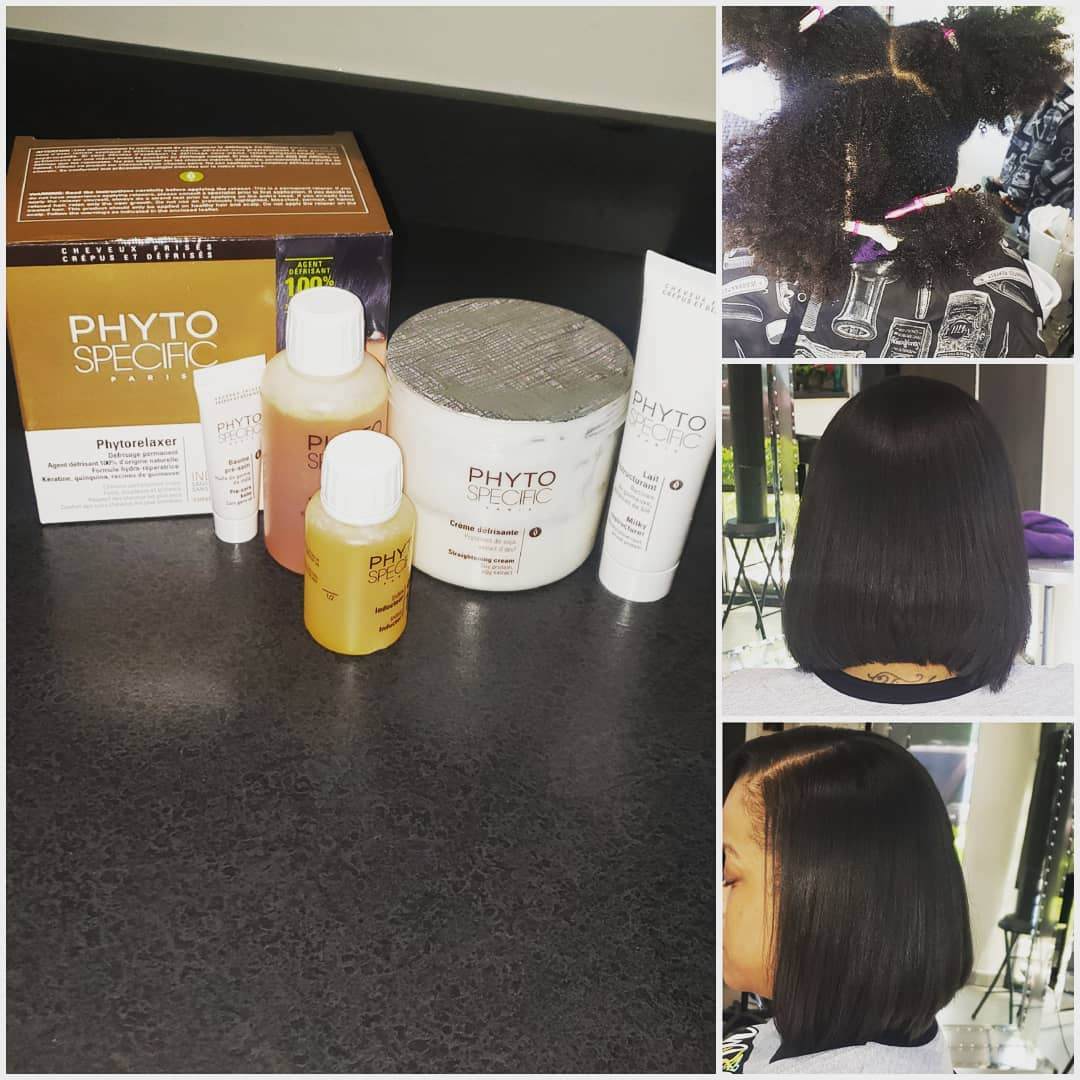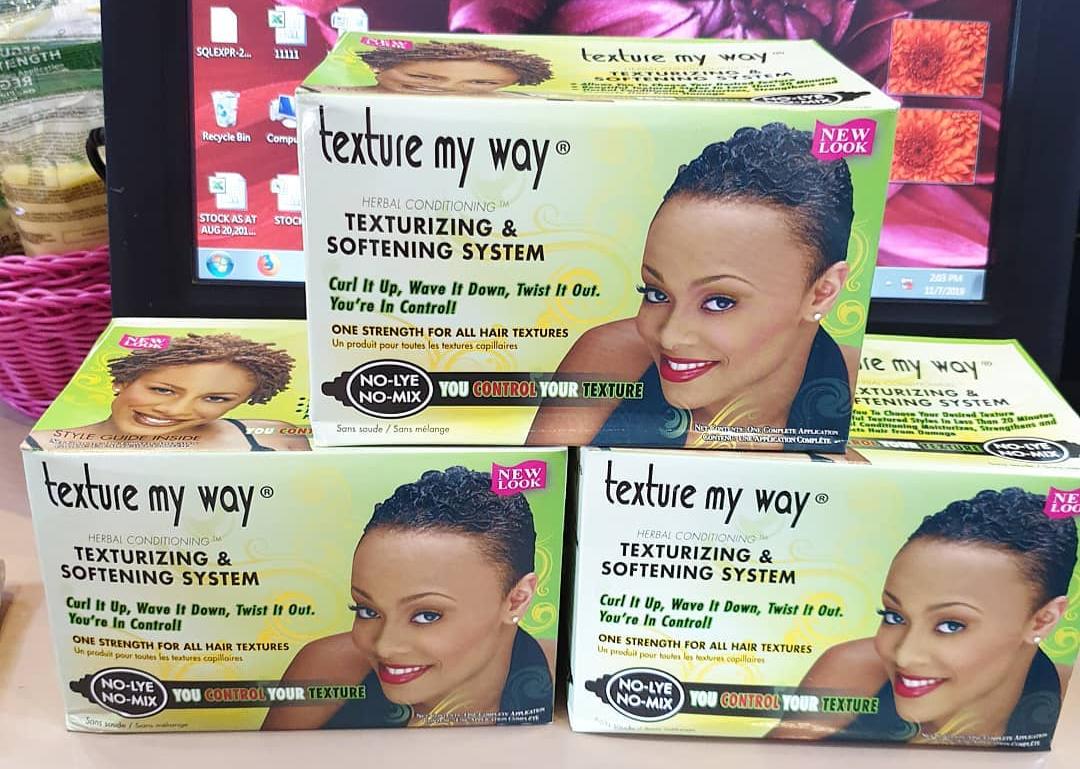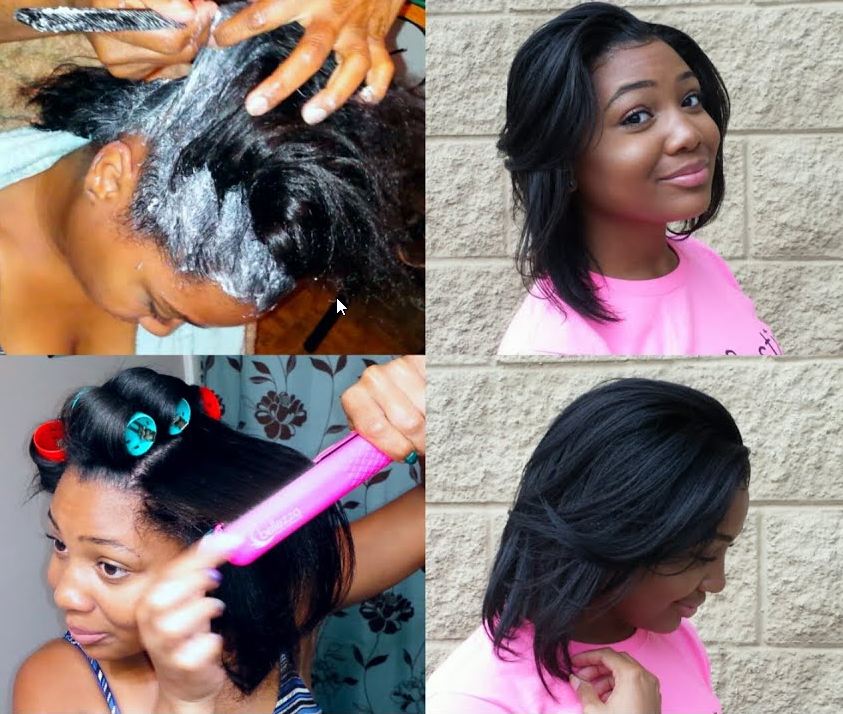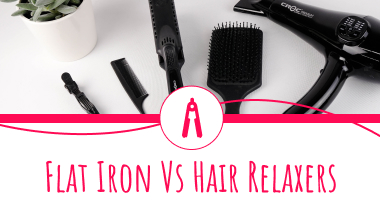Texturizers vs Relaxers: Which One to Pick for Your Hair Type?
Haircare is a multi-billion dollar industry that has been around for thousands of years. The methods and products have changed over time, but the goal remains the same: to make people feel beautiful.
One way in which people try to make their hair more beautiful is by changing its texture. There are two common ways of doing this: texturizers and relaxers. Texturizers work by loosening the curl pattern of natural hair, while relaxers straighten it out completely.
So which is better? It really depends on what you’re looking for in terms of styling options and how much time you want to spend doing it every day!
In this article, we will discuss what these two products do and what you can expect from them. We’ll also compare relaxers vs texturizers and help you decide if one is worth trying over the other based on your personal needs.
What is Hair Relaxer
Hair relaxer is a type of hair care product that is used to change the texture of hair by chemically breaking the S-S bonds in the hair shaft. This makes the hair less curly and more manageable.
Hair relaxers come in two main types: lye and no-lye. Lye relaxers are stronger and can be more damaging to the hair, while no-lye relaxers are less harsh. Both types of relaxers contain chemicals that break down the hair shaft, but the ingredients vary.
Hair relaxers are used by people with natural, curly, or coarse hair to make it more manageable. The product is applied to wet hair, left on for a set amount of time, and then rinsed out.
In order to get the best results, it is important to follow the instructions on the package carefully. Hair relaxers should not be used frequently, as they can damage the shaft and lead to hair loss.
Are there any non-chemical relaxers?
A non-chemical relaxer is a type of hair care product that does not contain the harsh chemicals required to break the S-S bonds in the hair shaft.
Non-chemical relaxers are made from less damaging ingredients but have been known to have some side effects such as hair damage and scalp irritation. In order to minimize these risks, it is important to follow instructions carefully. Non-chemical relaxers should not be used frequently due to risk factors such as scalp irritation.
What are some common ingredients in a lye relaxer?
Some of the common ingredients found in a lye relaxer include sodium hydroxide, potassium hydroxide, lithium hydroxide, and ammonium thioglycolate. These chemicals work together to break down the protein bonds in the hair shaft, which leads to a change in the texture of the hair.
What are some common ingredients in a no-lye relaxer?
Some of the common ingredients found in a no-lye relaxer include glycerin, lanolin, and Cetearyl alcohol. These chemicals work together to break down the protein bonds in the hair shaft, which leads to a change in the texture of the hair.
Hair Relaxer Advantages
There are not so many advantages of using a hair relaxer but they are pretty straightforward.
The most obvious benefit is that it can make your hair look smoother and less frizzy. A hair relaxer can also help to make your hair more manageable, making it easier to style.
- If you have naturally curly hair, using a hair relaxer can help to loosen the curls and make your hair completely straight;
- A hair relaxer can also help reduce irritation caused by frequent heat straightening of your hair, which can damage it over time;
- You do not need to limit the time spent washing your hair because of how often you have to straighten it;
- It gets rid of frizz: using a relaxer will help to get rid of the frizzy texture that is often associated with natural African-American hair;
- Gives hair a sleek appearance: relaxed hair appears smooth and shiny, which can often be the desired look.
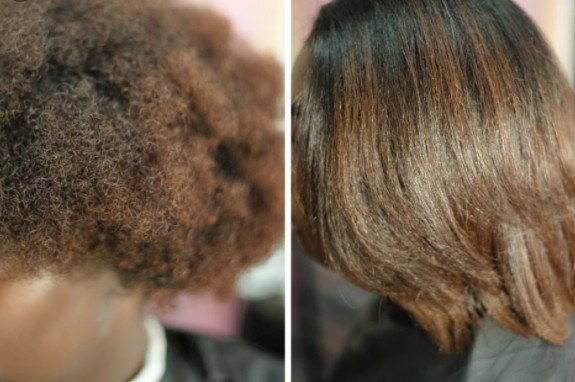
Hair relaxer before and after
Hair Relaxer Disadvantages
There are a few disadvantages of using a hair relaxer. One is that it can cause damage to your hair. It can also make your hair brittle and dry, and it can strip away the natural oils in your hair.
Another disadvantage is that it can be expensive to use a hair relaxer regularly.
If you decide to use a hair relaxer, it is important to choose one that is appropriate for your hair type. You should also follow the instructions carefully, and avoid over-processing your hair. If you do experience any damage or other problems as a result of using a hair relaxer, be sure to seek out advice from a professional hairstylist or dermatologist.
Relaxers should never be applied by anyone who can’t even properly read an instruction. A relaxer contains chemicals that can be dangerous if they are handled incorrectly.
There are several severe side effects of incorrectly used relaxers, including burning your scalp or skin, causing redness or rashes, changing your hair texture for the worse, requiring repeated treatments over time to achieve the same results as before, developing an allergy to the product or even experiencing hair loss.
In conclusion, while hair relaxers can be beneficial in some cases, they also come with some potential risks. It is important to weigh the pros and cons before making a decision about whether or not to use one. If you do decide to use a hair relaxer, be sure to take precautions to minimize any potential damage.

Hair relaxer before and after
Are there any risks associated with using a hair relaxer?
Yes, there are some risks associated with using a hair relaxer. One of the main risks is that the chemicals can cause damage to the hair shaft, which can lead to hair loss.
Another risk is that the relaxer can cause scalp irritation, which can be painful and lead to further complications. It is important to follow instructions carefully when using a hair relaxer in order to minimize these risks.
How often can I use a hair relaxer?
It is recommended that you do not use a hair relaxer more than once every six to eight weeks. This is because the chemicals can damage the hair shaft and lead to hair loss. If you do need to use a relaxer more often than this, it is important to use a milder formula and be very careful when applying it.
What Is Hair Texturizer
Hair texturizer is a cosmetic agent that is used in order to alter the texture of hair. It is a thickening or softening agent that is typically applied to the hair shaft. Hair texture can be changed only to a certain extent, but it is widely used by black people in order to straighten their hair or make one’s hair more manageable.
The active ingredient in hair texturizer is usually sodium hydroxide. Just like in a relaxer it works by breaking the disulfide bonds in the hair shaft. This opens up the hair cuticle and makes it more pliable. The texturizer is then able to penetrate the cortex of the hair and change its texture.
Sounds exactly like a relaxer, doesn’t it? Usually, the only main difference is the time a product must be applied and the concentration of its active ingredients.
Hair Texturizer Advantages
Hair texturizers are used to temporarily change your hair’s texture. If you’re looking for a softer, more workable hairstyle, then this is the product for you.
For example, if you like straightening your hair but also want it to be wavy or curly in parts, instead of having to straighten and curl separately or use multiple products on your hair (which can leave it dry), with a few passes of the flat iron, you can get both effects.
Another advantage is that it is much easier to maintain and you can use less heat.
Hair Texturizer Disadvantages
Texturizers for hair are above all a permanent relaxer alternative. There is no overall evidence of health problems linked specifically to the use of these products.
However, just like relaxers, these chemicals may cause dryness, breakage, and irritation if they are used incorrectly or come in direct contact with eyes or other sensitive areas. Pulling gloves should always be worn when applying texturizer so as not to skin irritation during the application process.
Additionally, texturizers should not be used near the scalp as they can be irritating to this area. Finally, it is important to follow the directions for use carefully in order to avoid any potential problems.
Another disadvantage to using hair texture softeners is that they may not be suitable for all hair types. For example, those with tightly coiled or curly hair may find that a texturizer leaves their hair feeling dry and frizzy.
While some texturizers claim to provide an alternative to permanent relaxers, their effect is not nearly as long-lasting. This means that users of such products may actually still require a permanent relaxer periodically in order to maintain straight hair.
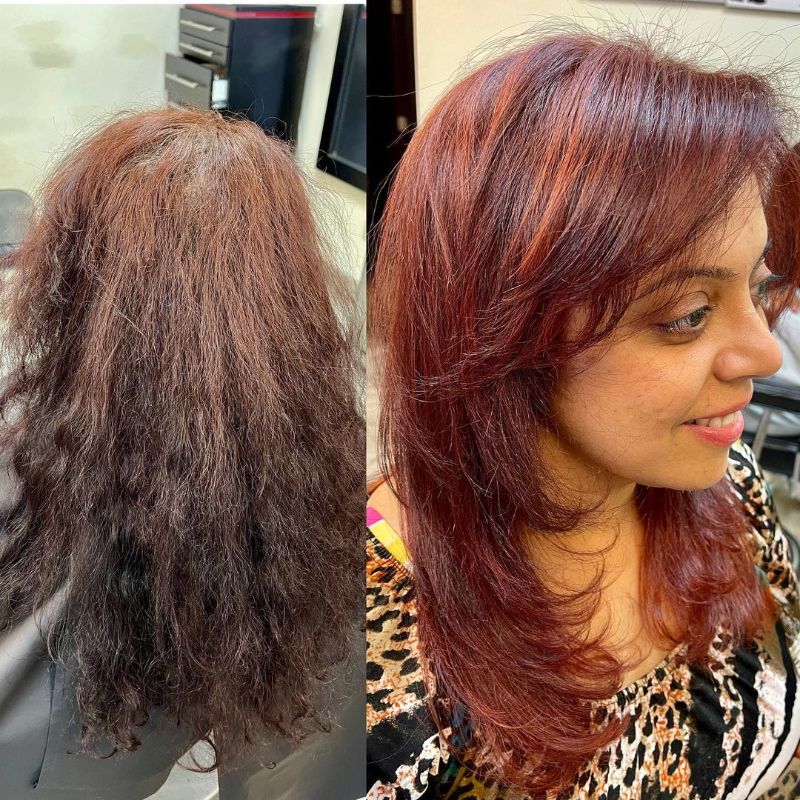
Hair texturizer before and after
Comparing Hair Relaxers vs Texturizers
Do both texturizers and relaxers damage natural hair?
The answer to this question is not a straightforward one. There are many factors to consider when answering this question, including the type of texturizer/relaxer used, the method of application, and the natural hair type of the individual. Generally speaking, texturizers/relaxers can be damaging to natural hair if they are not used properly.
One of the main concerns with these chemical straighteners is that they can be harsh on the hair. This is particularly true for those who have natural hair that is delicate or prone to breakage. If a texturizer or relaxer is applied incorrectly, it can cause damage to the hair shaft, which can lead to breakage and frizziness.
Are texturizers less damaging than relaxers?
Texturizers tend to be less damaging to the hair than relaxers. This is because texturizers do not contain the same amount of chemicals as relaxers, and require less time to be in contact with your hair.
What hair will benefit from relaxers or texturizers the most?
You probably can’t decide whether to pick a texturizer or relaxer for your natural black hair.
Texturizers work best on natural hair that is medium to thick in density, and that has a moderate to coarse texture. Fine hair can also benefit from using a texturizer, but it is important to avoid over-processing hair that is thin in density.
The type of hair that will benefit from relaxer the most is thick, curly, coily and prone to frizz African American hair. A relaxer will help to straighten even the toughest natural hair and make it more manageable.
How long do they last?
Both relaxers and texturizers are a permanent treatment, which means you can’t wash them off etc. However, your hair will still lose its initial form as it grows.
So how long do a texturizer and relaxer last?
This is a difficult question to answer because it depends on a variety of factors, including the type of hair relaxer used, the strength of the relaxer, and the individual’s hair type. In general, however, both hair relaxers and texturizers tend to last for about 6 to 12 weeks until they need a touch-up.
It is important to note that the longevity of hair relaxers varies from person to person. Someone with coarse, thick hair may notice that their relaxer lasts longer than someone with fine, thin hair.
You will often have to apply a new relaxer every 10–12 weeks in order to achieve satisfactory results. Some individuals find that they need a new relaxer application after only six weeks because of an increase in the rate of hair growth.
How much do they cost?
The price for both hair relaxing and texturizing services can vary depending on the salon, but typically these services cost between $150 and $250.
If you want to do the treatment yourself, products start from as little as $10.
How much time does it take to apply?
The amount of time it takes to apply a hair relaxer will vary depending on your hair type and the specific relaxer you are using. However, most people find that it takes between 30 and 45 minutes to properly apply a hair relaxer.
Note that this is the duration of the whole process that contains several steps. You should never leave a relaxer itself on your hair for more than 15 minutes.
It should usually take less time to apply a hair texturizer (about 20-30 minutes), depending on the product you use. Be sure to read the instructions carefully, as some products may require a longer or shorter application time. The texturizer itself should be applied for no more than 5-10 minutes.
How to Maintain Relaxed Natural Hair?
The best way to maintain relaxed natural hair is by using a regimen that will keep your hair healthy and hydrated. This includes washing your hair with a gentle shampoo and conditioner, using a moisturizing treatment, and protecting your hair from the sun and wind. You should also avoid using heated styling tools, which can damage your hair.
Many naturals complain that they aren’t able to build a good lather when washing their hair. Relaxed hair has been stripped of its protective barrier, which means that it’s easier for dirt and oil dust to accumulate on the surface of the hair.
When you add water, this may cause some of the dirt and oil to be pushed into your hair shaft, which can cause irritation and grody buildup. If you’re having trouble getting a good lather when shampooing relaxed hair, consider using a clarifying shampoo once or twice per week. This type of shampoo will rid your hair of built-up products so that you can get a better lather from your regular shampoo.
If you have relaxed hair, you should condition your hair every time you shampoo it. This will help to replace the moisture that has been lost during the cleansing process. Look for a conditioning shampoo and conditioner that are specifically designed for relaxed hair. These products will help to detangle your hair and reduce frizz.
Summarizing Texturizer Versus Relaxer Battle
Having straight hair can be challenging. However, there are products that can make your journey easier. As you could see the difference between texturizer and relaxer is not as big as you might think.
Hope you liked our tips on how to manage your hair at home and whether a relaxer or texturizer is better for your hair. Make sure to read the instructions carefully and take proper care after the treatment.
Also read:
- Best Relaxers for Men Hair
- Heat Protectants for Relaxed Hair
- Phytorelaxer Review
- How to Straighten Permed Hair
- How to Wash Coconut Oil Out of Hair
- How Often Should You Wash Black Hair
- Why Does Hair Curl at the End
- Coconut Oil Ruined My Hair
- Best Detanglers for Natural Hair
References:
- Hair Biology & Bonds – https://www.philipkingsley.com/hair-guide/hair-science/the-biology-of-your-hair
- Chemical Hair Relaxers Have Adverse Effects a Myth or Reality – https://www.ncbi.nlm.nih.gov/pmc/articles/PMC3746223/
- Sodium hydroxide – https://pubchem.ncbi.nlm.nih.gov/compound/Sodium-hydroxide
- Cetearyl Alcohol: What You Need to Know About This Common Ingredient – https://www.healthline.com/health/cetearyl-alcohol
Table of Contents
ToggleAllyson Carter
Ally is a professional hairstylist with more than 6 years of experience, but hair has been her passion since early childhood. Here, at Hair Spies, she blogs about all things hairdressing, hair tools, and everyday hair care. Read more about Allyson here.
